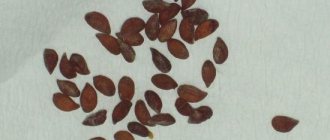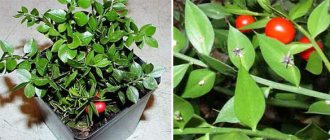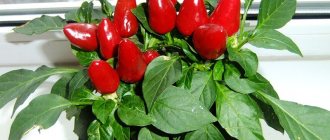In this article you will learn how to grow pineapple at home. At first glance, this seems like a complicated matter, but in reality everything is very simple.
Increasingly, on home windowsills you can find growing lemon, tangerine, mango, pineapple and many other exotic and not yet quite familiar to us fruits. It is quite possible to grow such a miracle at home; all you need is desire and patience. Today we will talk about growing one of the most popular fruits at home - pineapple.
How to choose the right planting material for growing pineapple?
It is important to immediately note that this plant can be grown not only with the help of its “tuft”; seeds and root cuttings of an adult plant are also used for these purposes. If you want to plant this exotic plant at home using its top, then first you will need to purchase a suitable pineapple.
A ripe and pleasantly smelling fruit would be suitable in this case :
- First, appreciate the aroma of pineapple. If you smell the fruit, but do not feel any odor, this indicates that it is not yet ripe and, accordingly, it will not be suitable for planting. The ripe fruit has a fairly pronounced and very pleasant smell.
- Now look at the fruit. It must be intact, not deformed or rotten . The fact that the fruit has begun to rot will be indicated by dark spots on it and between its scales. Also evaluate the color of the pineapple, it should be uniform. Most often, a ripe fruit has a yellowish color; if the fruit is green, this indicates its immaturity.
The pineapple should be ripe and aromatic
- For planting, you need a moderately ripe pineapple ; an overripe fruit is definitely not suitable. To determine if it is suitable for planting, press it lightly. If the fruit is overripe, it will be very soft, you can literally pierce it with your finger, while green pineapple, on the contrary, will be hard. If, when you press on the scales of the fruit, they seem to spring back, then this means that the fruit is moderately ripe.
- It is also very important to examine the very top of the fruit . It should be green and its edges a little dry. If the leaves are yellow or rotten, then this fruit cannot be taken.
- Another sign of a suitable fruit is a hollow sound when you tap it.
As for pineapple seeds, you need to buy them based on the following tips:
- If you are careful, you will notice that the pineapples sold in our stores, as a rule, do not have seeds. The thing is that such pineapples are bred and not wild. Sometimes pineapple contains such seeds, but more often than not they are unsuitable for further manipulation.
- That is why it is recommended to buy seeds in special stores to grow this exotic miracle.
- The seeds must not be dry or damaged; you also need to pay attention to their size - they should not be too small.
Growing from seeds
Regarding root cuttings , you can take cuttings from a plant during fruiting or after this process. It is important that the shoots to be separated are of sufficient size, approximately 15-20 cm. In this case, the plant from which the cuttings will be taken must be absolutely healthy and strong.
Description of the plant
Pineapple is a herbaceous plant, in the center of which a stem always grows. If you examine it carefully, you can see that right at the top of the stem there is an inflorescence, which subsequently turns into infructescence. The individual berry parts of this fruit grow together into one pineapple.
The stem is surrounded by a rosette, which consists of leaves, thick and fleshy. The fruit shape of this plant is oval and cylindrical. It consists of small parts that have grown together. There is a rosette of leaves at the top of the pineapple.
The fruit itself is enclosed in a shell of scales. If the pineapple is ripe, it may be yellow, dark green, reddish or brown. Its flesh is rich yellow.
Almost everyone has tried pineapple and knows that its taste is pleasant and complemented by an excellent aroma. If the fruit is fully ripe, it can weigh up to five kilograms.
How to grow a pineapple from the top at home: preparation
It should be noted that most often this exotic fruit is grown in this way, since it is the fastest and easiest.
The success of such cultivation directly depends on the quality of the planting material and how correctly it is prepared for planting. So, first, choose a pineapple based on the above recommendations. Next, you need to separate the “tuft” from the fruit itself. You can do this in several ways:
- Take all the pineapple leaves in your hand and squeeze them quite tightly. Next, carefully turn the greens. If the pineapple was chosen correctly, the top will turn and separate from the main part of the fruit. In this case, a little stem should remain at the bottom of the top.
- If it is not possible to separate the planting material in this way, use a knife. Carefully cut off the top of the fruit along with the top. Next, use a knife to separate the entire edible part from the top. Be careful, if even a little fruit remains along with the “tuft”, this will lead to its rotting.
- When you, using one of the methods, separate the planting material from the fruit, also carefully remove a couple of lower leaves from the “tuft”.
Separate the top
- After this, hang the planting material in a dry place and leave it for a day. The top should dry out a little.
- After the specified time, take a container of water, preferably a glass, and place the top in it. Be careful, there should only be a bare trunk of the “crest” in the water.
Place in water
- Now you need to move the planting material along with the glass to a windowsill or table and wait for the roots to sprout. As a rule, this process takes about 1 month.
- The water in the container needs to be changed from time to time, and you also need to make sure that there is always enough of it.
- When the top takes root and they reach about 3 cm, the planting material will be ready for further manipulations, which you will learn more about below.
How to fertilize and water a pineapple?
The plant does not need much fertilizer to grow and later produce flowers and fruits. It is enough if he receives nutrients every two weeks in the summer and every four weeks in the winter. For this purpose, liquid fertilizer for flowering plants is suitable, which is added to the water for irrigation. Fertilizer should never be applied directly to a dry substrate, as this can damage the roots and cause burns.
Pineapple needs more water in summer than in winter. Also, don't water it too much. When watering this plant, you need to remember:
- use soft water without scale;
- rainwater is ideal;
- the substrate must be constantly moist and not dry out;
- You also need high air humidity - daily spraying with water or placing it near a humidifier.
How to properly plant a pineapple from the top and care for it after planting?
So, after the planting material has been prepared, you can begin planting the plant itself. At this stage, it is necessary to pay attention to the soil in which we will plant the plant. Suitable for our purposes:
- Self-prepared soil, which can be obtained by mixing sand, peat and ordinary soil in equal proportions
- And also soil for cacti purchased in a special store.
- And one more thing, in addition to the earth, we will need expanded clay
As for the capacity, to begin with it will be enough to take a small pot, which will have a volume of about 1 liter.
- We take a container and pour expanded clay onto its bottom. Its layer should be large enough, since this material will serve as a drainage system.
- Next, fill the container with the selected soil.
- It is recommended to pre-moisten the soil, but do not make the pot completely muddy.
- Now make a hole in the ground; its depth should be such that the top trunk can easily fit into it.
- Carefully place the “tuft” in the hole, fill the hole with earth, and lightly tamp it down. It is permissible to sprinkle the lower leaves a little with soil, but the rest should not be immersed in the ground.
- Check that the top is firmly anchored in the ground and does not fall. Water the plant a little.
Growing Pineapple
- After carrying out all the above manipulations, it is necessary to “hide” the plant in a bag. In this way, the conditions necessary for its rooting will be created. Remove the bag from the pineapple regularly to ventilate it. You can completely remove the bag when the fruit has taken root.
- Now choose a permanent place for the planted fruit. The room in which the pineapple will grow must be warm, without drafts. At the same time, you cannot place the container with the plant in a place where it will be exposed to direct sunlight, near radiators, heaters, stoves, etc. Pineapple is contraindicated in cold, drafts, dry air and constant exposure to the sun.
- Also water your pineapple regularly , using only warm water. As for its quantity, it all depends on the requirements of the plant. As soon as the top soil becomes dry, water the fruit generously. Do not forget, it is important to moisten the soil not only on the surface of the pot, but also below.
- You can periodically feed the plant with fertilizers, this will also have a beneficial effect on its growth and development. You can buy them at any flower shop.
- Next, keep an eye on the plant; after about a couple of months you will see that the leaves of the “tuft” disappear, and new ones appear in their place. This is a good sign and will indicate that the plant has taken root and is actively growing. Carefully remove dry leaves so that they do not interfere with the growth of new ones.
- After about 1-1.5 years, transplant the plant into a larger container. This can be done at almost any time, with the exception of the flowering period. You need to replant a pineapple without shaking off the soil from its roots.
Landing
Pineapple is a crop that is demanding when it comes to living conditions. For successful cultivation, you need to carefully select the planting container and soil.
How to choose soil and container
The pot for planting should be low and wide. You can take a deep container, but in this case it must be filled 2/3 with a drainage layer. Preference should be given to clay pots, as the roots receive more oxygen in them.
You can use ready-made mixtures for palm trees as soil or make your own soil mixture. To do this you need:
- 3 parts of turf;
- 3 parts acid peat;
- 2 parts rotted humus;
- 1 part sand.
A ready-made substrate for orchids is well suited for growing pineapple.
Holes and drainage holes must be made at the bottom of the pot to prevent liquid stagnation.
Landing Features
Rules for planting cut tops:
- Make a small mound of soil in the center of the container.
- The top is placed on the top of the earthen mound and slightly pressed into the ground.
- The soil is sprayed with warm water, avoiding excessive moisture.
- The top of the pineapple is covered with a cut plastic bottle, glass or cellophane.
- Place the container with pineapple in a bright, warm place.
Rooting occurs by the end of the second month. The beginning of this process can be determined by the growth of leaves. As soon as they begin to grow, the shelter can be removed and after a week the plant can be moved to a permanent location.
Sprouted roots are very fragile, so the leafy crown must be planted very carefully. Landing rules:
- The top is buried 2-3 cm into the soil.
- Supports secure the plant so that it does not fall under the weight of the leaves.
- Water with warm water, avoiding excessive moisture.
The plant planted in this way is left in the same room where the roots were sprouted. Spray with warm water daily. After 2-3 weeks, the plant is transferred to a permanent place.
How to grow pineapple at home from seeds?
This method of growing such exotics is considered the most difficult and requires certain skills in this matter, as well as great patience.
- Purchase plant seeds from a specialty store. As a rule, they do not require any additional processing.
- Prepare a container and fill it with soil made from soil, sand and peat (mix everything in equal proportions).
- Planting material is sown in the prepared soil to a depth of about 1.5 cm. It is not worth sowing the seeds deeper, they may simply not sprout.
- Now moisten the soil with warm water and wrap the container in film or use a plastic bag.
- Provide future plants with the necessary conditions. To do this, place the container with planting material in a warm place.
- After 2-6 weeks you will be pleased with the first small sprouts. How quickly you see seeding results depends on the temperature at which the seeds develop. The warmer the room, the faster the seeds will germinate.
You can grow pineapple from seeds
- Small sprouts also need care. Be sure to water them and also feed them with the necessary fertilizers and do not leave them in the scorching sun. Regularly remove the bag or film to ventilate the seedlings.
- When you see that the pineapple leaves have grown and reached a length of 5 cm, feel free to pick them. To do this, prepare the soil from soil, sand, peat, humus and charcoal, or buy a ready-made composition in a specialized store.
- Next, also monitor the temperature and humidity levels in the room. If necessary, fertilize the pineapple and replant it in a large container.
If you still decide to try to grow a plant from seeds that you find in a purchased fruit, then before planting, be sure to treat them with a weak solution of potassium permanganate, and then let them dry completely from the liquid.
Useful properties of pineapple
The fruit is widely used in cooking, cosmetology, medicine, and dietetics. Pineapple pulp contains bromelain. This component facilitates digestion and helps get rid of excess weight. The weight loss effect is enhanced by the large amount of fiber, which accelerates digestion and metabolism.
Fresh fruit contains a large amount of vitamins and minerals. In canned form, most of the nutrients are lost. The vitamin C content in pineapple is 1.5 times higher than in lemon.
Bromelain is used in medicine as part of some anti-inflammatory, decongestant and painkillers. Pineapple can be used as an additional remedy in the treatment of cardiovascular diseases, arthritis, and some types of inflammation. Pineapple helps well in treating bruises, abrasions, insect bites and minor burns.
In cosmetology, pineapple is used to lighten the skin and remove age spots. Due to organic acids, with the help of fruit, you can cleanse the skin, strengthen small blood vessels, and saturate the tissues with essential microelements.
There is an observation that people snore less if there is a pot of pineapple next to the bed. Scientists believe that the plant produces increased amounts of oxygen and improves the composition of the air around it. Thanks to this, people with snoring problems begin to sleep better and more soundly, and the noise level from them is noticeably reduced.
How to grow pineapple using root cuttings?
This method is suitable for those who already have an adult plant at home. By transplanting cuttings you can please yourself with a large number of new exotic plants.
- The plant can be propagated in this way during its fruiting or after this process.
- Only those cuttings that have reached approximately 15 cm are considered suitable.
- To obtain planting material, you can use a knife to carefully cut off the shoot or simply tear it off with your hands. We described a similar process earlier when we talked about planting a pineapple from the top.
- The damaged area on an adult plant must be sprinkled with wood ash.
- Now carefully hang the planting material and let it dry for 2-3 days. It must be hung with the leaves facing down.
- Next, you can either germinate the roots of the cutting by placing it in a container with water, or leave it and let the “wounds” overgrow a little, then treat it with wood ash and plant it in the ground. Sometimes only the separated cuttings already have small roots, in this case there is no need to grow them further, you can immediately plant the plant in a pot.
Cuttings
- You need to plant pineapple in a mixture of soil, peat and sand or in ready-made soil, which can be bought at a specialty store.
- The container must have drainage, otherwise the water will stagnate in the pot and the plant will begin to rot.
- After planting, the cuttings need to be watered, covered with a bag and taken to the warmest room. Periodically, the bag needs to be removed and the plant needs to be sprayed or watered a little.
- A couple of months later, after the planted pineapple begins to grow new leaves, evaluate the condition of the plant. Start introducing fertilizing, do not cover it with the bag anymore.
- After 1-2 years, transplant the pineapple into a larger pot.
A little about pineapple
Pineapple is a tropical herbaceous plant whose fruits are famous for their juiciness, unique sweet and sour taste and aroma. Pineapple grows mainly in the tropics; the USA, Latin American countries, Thailand and the Philippines are considered the leaders in its production.
Contrary to popular belief, pineapples do not grow on palm trees. This fruit develops directly on the ground from inflorescences on densely growing herbaceous shoots. Today it is popular all over the world, but before Columbus's voyages in the Old World it had never been heard of. Having tasted the strange fruit, Europeans soon began making attempts to grow it at home in greenhouse conditions. This tradition has reached us, so we are not the first to try to grow pineapple in a pot: gardeners have been doing this for more than half a century. The passion for growing pineapples reached Russia a little later. But already in the 19th century, the presence of a pineapple greenhouse in a noble estate was considered a sign of special prestige.
Interesting: the word “pineapple” in Indian dialect means “smell of odors.”
How to properly care for an adult pineapple at home?
Planting a plant is only half the battle. The most important point is proper care for an already mature pineapple, because without the necessary conditions, the plant will not bloom and certainly not be pleased with the harvest.
- Lighting . This plant loves light and needs enough of it. If in the warm season a pineapple can simply be placed on the windowsill and this light will be enough for it, then in winter you also need to use a special lamp that will help increase daylight hours.
- Temperature. This culture loves warmth very much and, in principle, does not tolerate cold. If the thermometer shows +17 °C, this means that your exotic miracle is already cold. The plant will feel good if it is in a room where the temperature does not drop below +20 °C. For the same reason, you should not place a container with pineapple on a cold windowsill or balcony, especially if it is no longer summer outside. It is important to say that pineapple, like any other plant, senses changes in weather conditions outside the window, so in winter it needs to organize a little rest. At this time, it can be moved to a room with a temperature of approximately +18°C, while watering should be slightly reduced, as well as daylight hours.
- Watering. Watering should not be done very often, but the amount of water should be sufficient to moisten the soil not only in the top layer, but also below. A sure sign that the plant needs to be watered is dry soil. The procedure must be carried out exclusively with warm water. In addition to watering, the plant is also sprayed with a spray bottle; such a “shower” should be carried out on hot days.
Homemade pineapple needs proper care
- Fertilizer. Caring for an exotic plant can be considered good only if regular feeding is carried out. Pineapple needs different fertilizers; a consultant at a flower shop will help you choose them. As a rule, fertilize the plant more than 2 times a month.
- Transfer. Pineapple needs replanting every year. At the same time, you need to know that the plant is being replanted without disturbing its roots, that is, there is no need to shake off the soil from them. The volume of the container needs to be increased quite a bit.
- A container in which a pineapple grows. Such a container can be completely different, the main thing is that it matches the size of the plant. It must also be said that the container must have drainage, otherwise the pineapple will die sooner or later, never delighting you with its flowering and fruits.
Reviews from those who have already tried it
Many times I tried to grow a pineapple from a fruit bought in a store, I cut it and twisted it, put it in water and just dried it in the ground, whatever I did, in the end nothing good came out, either everything rotted, or the leaves simply turned black and that’s it here. Recently, my wife and I went to Thailand once again, I approached an elderly Thai fruit seller and asked him how you grow this fruit, maybe you will give me the seeds or sell me, he grabs a Pineapple from the shelf, unscrews the top and visually shows me what it is needs to be stuck into the ground. I accepted the gift, but he didn’t take any money from me for it. As I was eating the pineapples, there were a couple more tops in the room, which I twisted out on the advice of the Thai. The tops dried up and I packed them in a suitcase; when I arrived home they were still waiting for me for a couple of days with soil and pots. I did everything as the Thai recommended, namely, I just took it and stuck it in the ground, and within a week fresh leaves began to appear from the outlet. And the smallest specimen had babies :)))
deonisiy1982
https://forum.homecitrus.ru/topic/13-ananas/page-31
Once on March 8, my wife was given a pineapple at work. We ate it, but an idea was born - to try to grow pineapple in a pot... The idea was born from the stories of parents who, in Soviet times, during a business trip to Africa, planted them in the garden near their house.











